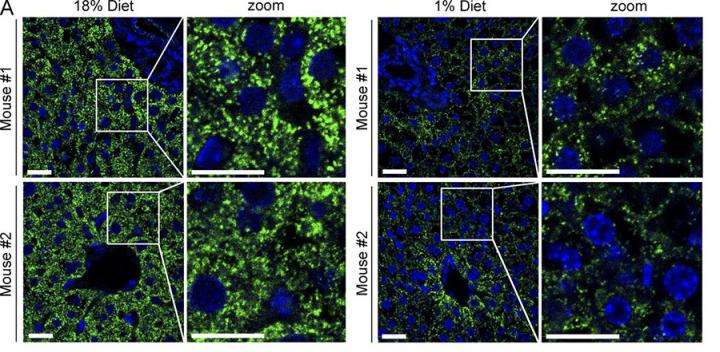Peroxisomes are degraded and PEX2 protein levels elevated in a mouse model of amino acid starvation. Mice were fed a control diet containing 18 percent protein (wt/wt) or a protein-restriction diet containing 1 percent protein (wt/wt). Representative images of fluorescent immunohistochemistry images thin slices of the livers stained with PMP70 (green) or DAPI (blue) as a marker of the nucleus. Images from two different mice for each diet conditions are shown. Bars, 20 μm. This image appears in The Journal of Cell Biology study by Sargent et al. Credit: © 2016 Sargent et al.
Malnourished children living in the same household who are given the same food to eat sometimes have stark differences in health, leading researchers to query why some severely malnourished children face death while others don't.
Researchers and global health experts have come to understand that simply giving food to severely malnourished children often does not lead to recovery. This is because severely malnourished children's bodies are affected on a deeper level that is poorly understood. To understand this further, an international team led by Robert Bandsma, MD, PhD, principal investigator with the Centre for Global Child Health at The Hospital for Sick Children (SickKids), and Peter Kim, PhD, senior scientist in the Cell Biology program at SickKids, studied this phenomenon in animal models.
Together with Barbara Bakker, PhD, a basic scientist from the University of Groningen in the Netherlands, the research team found that severe malnutrition could lead to dysfunctional liver mitochondria, which are essential for energy production, and a loss of peroxisomes, which are important for normal liver metabolic function. They published these results previously in "Malnutrition-associated liver steatosis and ATP depletion is caused by peroxisomal and mitochondrial dysfunction" by Tim van Zutphen et al. in the Journal of Hepatology.
In a new paper, "PEX2 is the E3 ubiquitin ligase required for pexophagy during starvation" by Sargent et al., published online Sept. 5 in The Journal of Cell Biology, they identify a gene, PEX2, as an essential requirement for the loss of peroxisomes in cells cultured without enough nutrients. In malnourished mice, they observe that the number of peroxisomes decreases as the amount of PEX2 goes up, which suggests that PEX2 may control the number of peroxisomes in the liver.
Combined, these study results could potentially lead to novel treatment strategies for severely malnourished children.
"This project is a great example of successfully bringing together leading basic scientists and clinical researchers, with the goal of addressing severe malnutrition in children," says Bandsma who is also an assistant professor in the Department of Paediatrics at the University of Toronto. "...Ultimately, these insights could lead to more effective interventions to reduce mortality in malnourished children."
Kim who is an associate professor in the Department of Biochemistry at the University of Toronto, adds, "What surprised me in the beginning was how little we knew about the basic cellular processes that are affected during severe malnutrition. Our work is a starting point for us to understand what happens in the bodies of young children during severe malnutrition. Only by understanding these basic cellular processes will we be able to provide new and innovative interventions for critically ill malnourished children."
The liver is a central organ in metabolism regulation. The novel work by this research team has demonstrated that in severe malnutrition these livers are unable to utilize nutrients effectively.
The authors will next investigate whether in low-resource settings, where severe malnutrition is prevalent, whether supplementation with specific nutrients that promote peroxisome and mitochondria activity together with current nutrition rehabilitation diets could potentially improve metabolic stabilization in severely malnourished children.
More information: Graeme Sargent et al, PEX2 is the E3 ubiquitin ligase required for pexophagy during starvation, The Journal of Cell Biology (2016). DOI: 10.1083/jcb.201511034
Journal information: Journal of Cell Biology
Provided by Rockefeller University Press



















